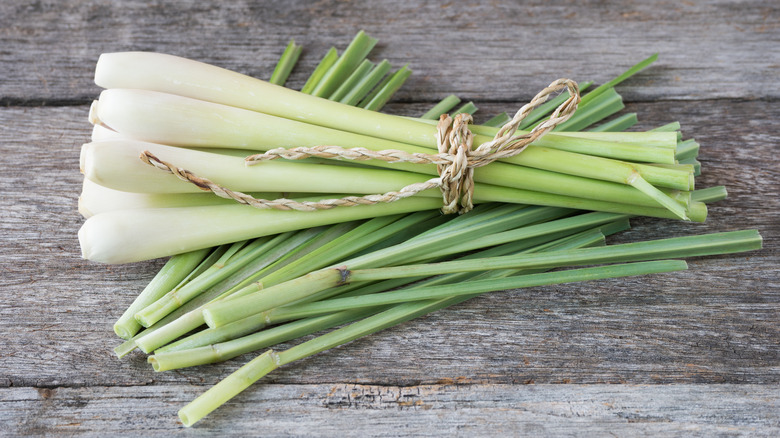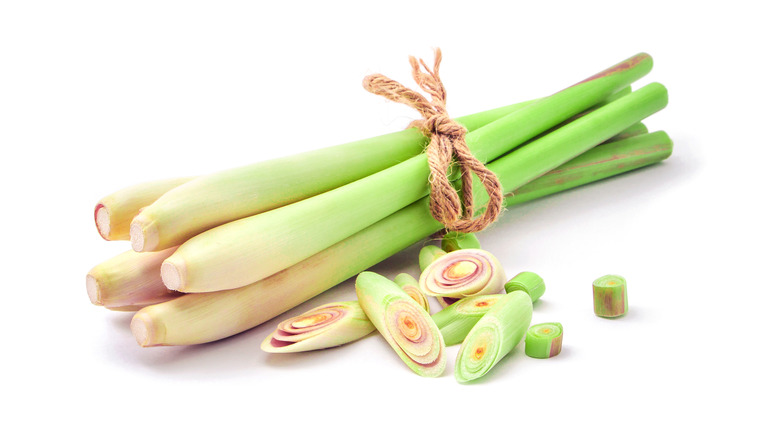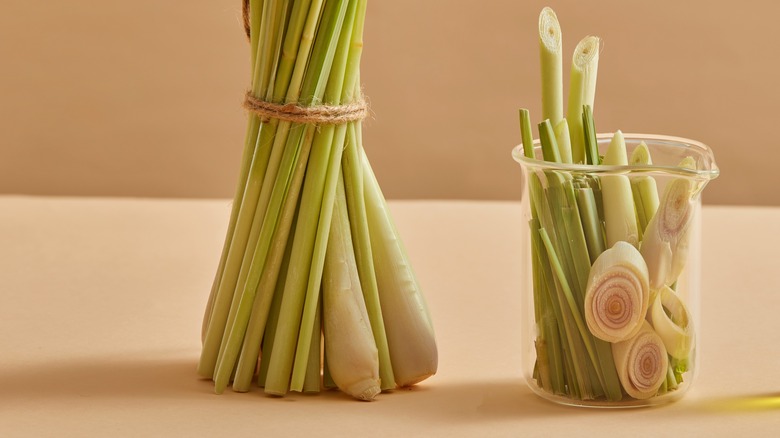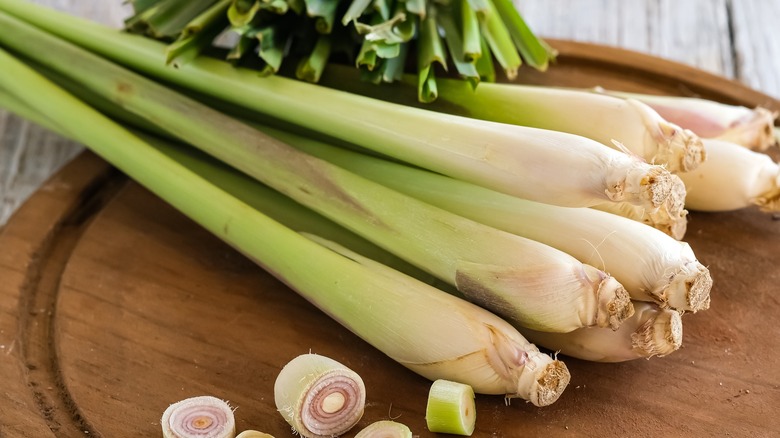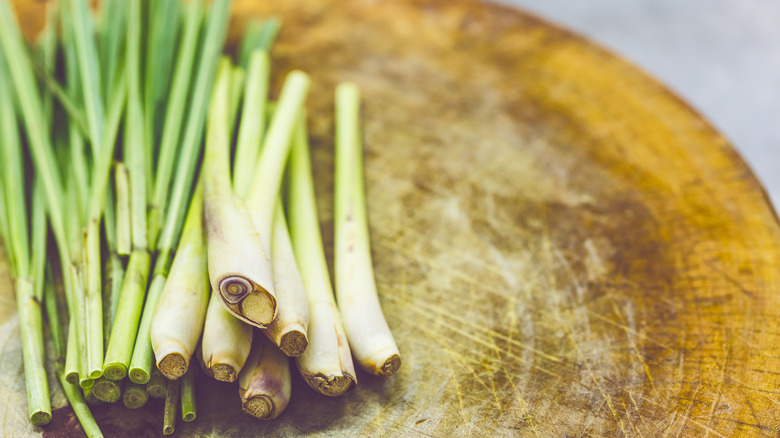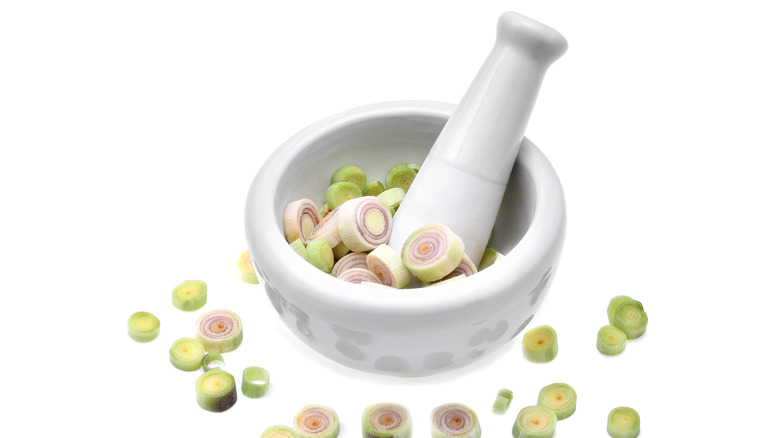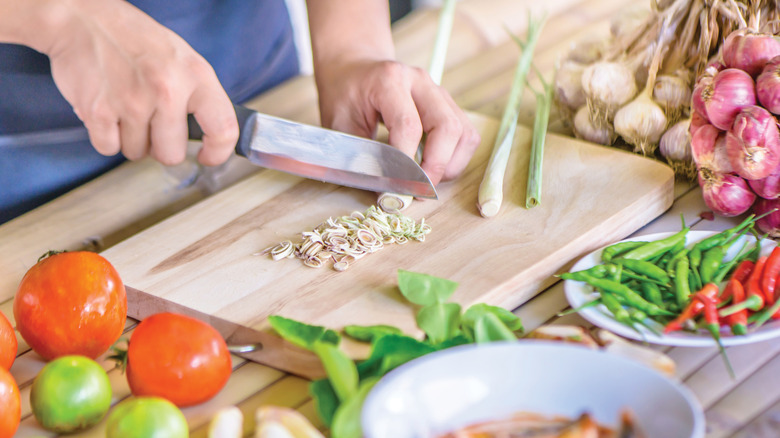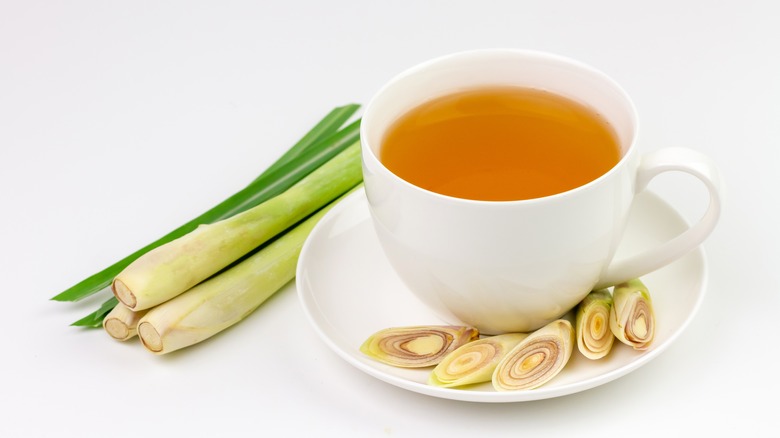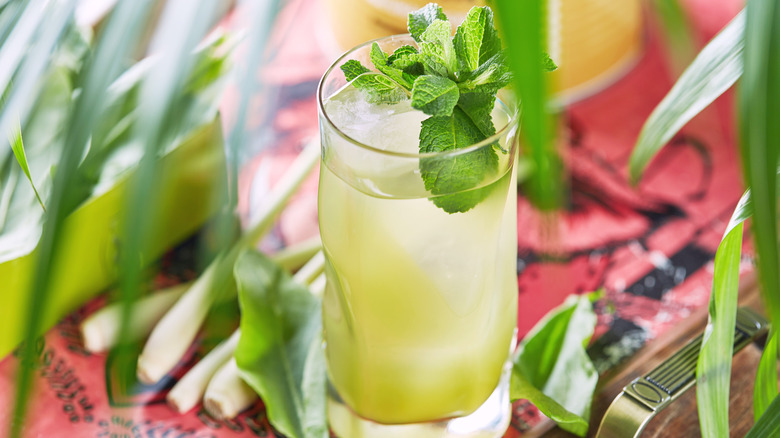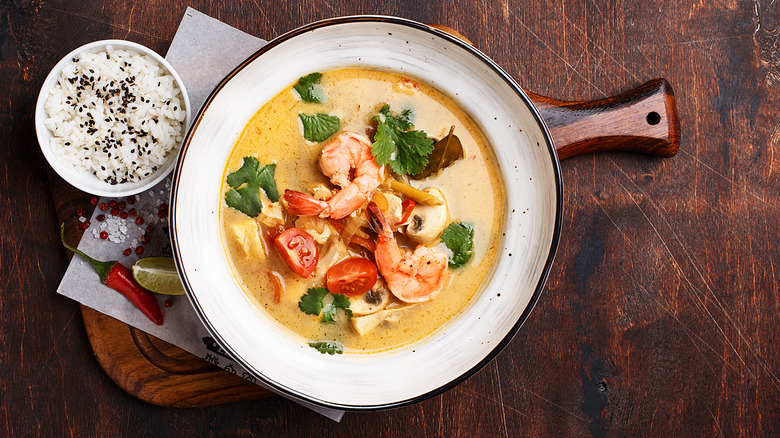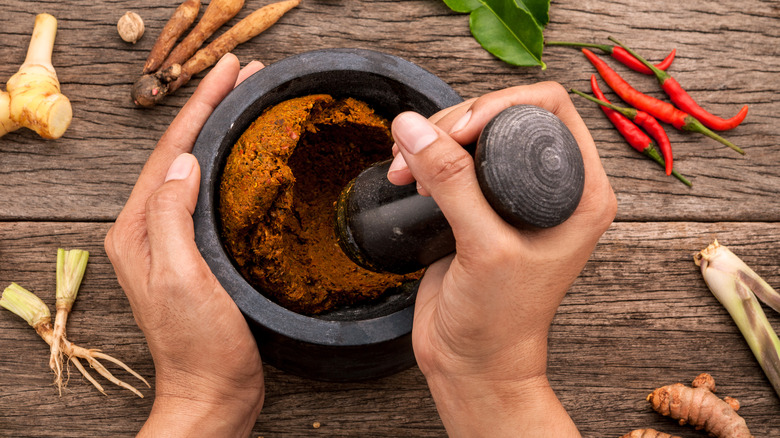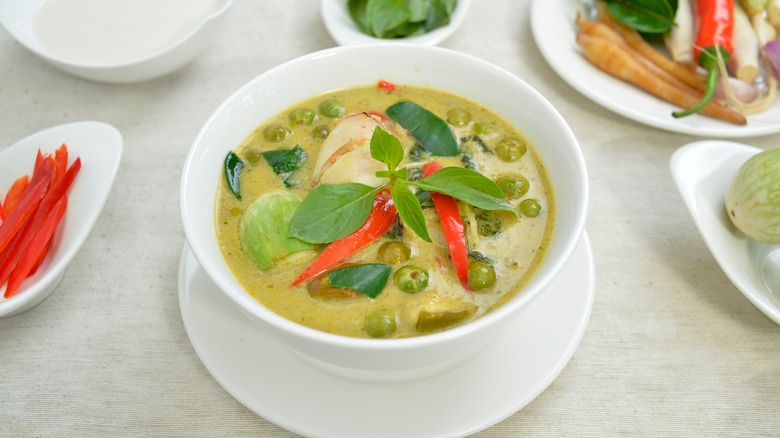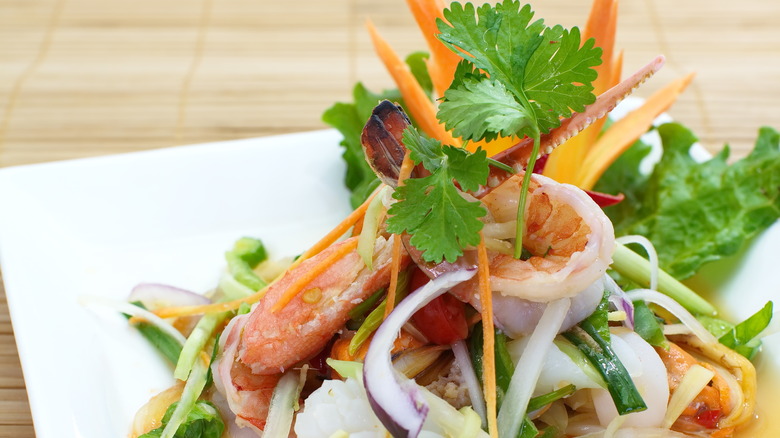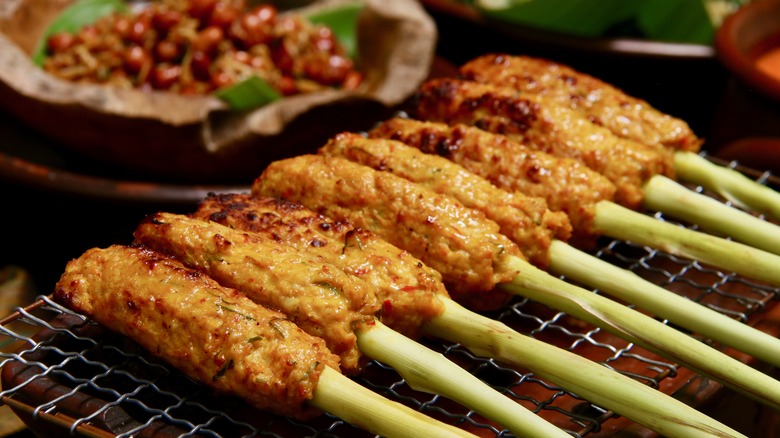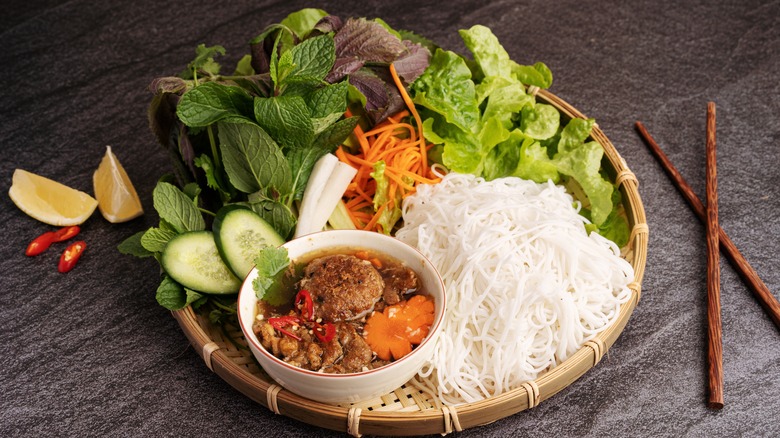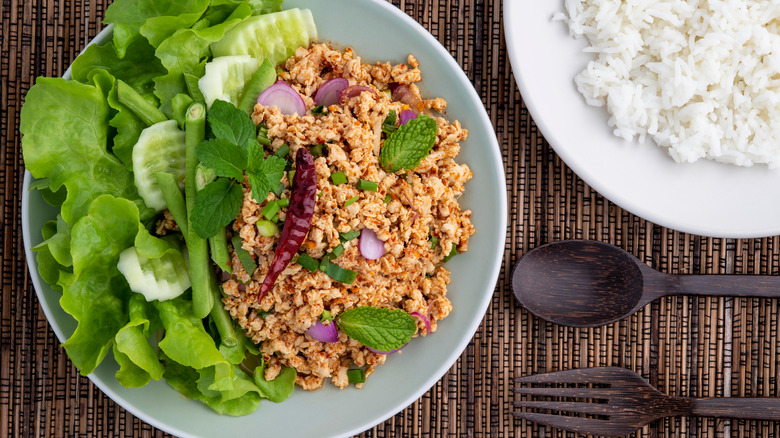15 Tips You Need When Cooking With Lemongrass
Lemongrass is an edible aromatic grass that thrives in warm tropical climates where it grows in bushy clusters and reaches heights of three to five feet. It's native to Southeast Asia but is now cultivated worldwide both commercially and as an ornamental plant in home gardens. It is traditionally found in many Southeast Asian cuisines, including Thai, Indonesian, Malaysian, Vietnamese, and Cambodian.
Lemongrass is highly fragrant and has a tangy flavor similar to citrus fruit but more floral and herbal with hints of ginger and mint. It imparts a citrus flavor without the acidity or bitterness that citrus juices produce. The trickiest part of cooking with lemongrass is preparing it. Since it's a fibrous woody plant, you must take special care to make it less stringy, so it is palatable. Once properly prepped, it's a versatile ingredient that can be used in beverages, soups, salads, marinades, chicken, meat, or dessert.
Select the best fresh lemongrass
You can purchase lemongrass in the produce section of an Asian grocer or at some specialty stores. In stores that sell fresh lemongrass, you'll likely to find it in the refrigerated section of the produce aisle. It's usually trimmed and bundled together in sets of a few stalks, secured either with a rubber band or in a plastic clamshell. It can almost resemble thick, short green onions. When buying fresh lemongrass, the most important thing is to rely on your senses. Look for stalks that feel firm to the touch, and have some heft to them. Visually, select lemongrass with pale yellow-green stalks and vibrant green leaves that haven't dried out too much. It should still resemble a living plant rather than a desiccated husk. Trust your nose; choose lemongrass that has a delicate but unmistakable fragrance. Underripe or old lemongrass doesn't have as much of an aroma as top-quality stalks do. The fragrance is one of the most valuable characteristics to look for in lemongrass. If it doesn't smell of citrus, it's likely past its prime.
Can't find fresh lemongrass?
Check the freezer section! Frozen lemongrass is a great alternative, and it's often sold already frozen. You may find it frozen as trimmed intact stalks, which means you'll have to do the preparation on it, or it may come preprepared and already minced or mashed into a paste. Tubes of lemongrass paste are also an excellent option when fresh lemongrass isn't readily available. These are usually located in the produce section near other fresh herbs.
If you have difficulty finding fresh lemongrass and you do manage to get your hands on some, you can regrow lemongrass shoots from the unused portions of the stalks. It's a variation on the well-known green onion trick. Simply take the stalk — root end intact — and place it upright in a glass with a few inches of water. Put it in the sun and change the water each day. After about two days, you'll see new shoots sprouting from the top. You can keep using and regrowing your lemongrass in between purchases.
Store your lemongrass properly
Once you've purchased your lemongrass, it's important to store it properly so you get the full benefit of your carefully selected stalks. You can store fresh lemongrass for up to ten days in the refrigerator before using it. To preserve its useability, wrap the root ends in a damp paper towel secured with elastic, similar to how cut flowers are frequently kept.
You can also extend the life of the lemongrass by freezing it or turning it into a paste yourself. You have two options when it comes to freezing fresh lemongrass: whole or ground. To freeze it whole, trim off the green leaves and seal the stalks in a sealed airtight bag. To use frozen whole lemongrass, thaw and use the same way you would use fresh lemongrass.If you opt to grind your lemongrass into a paste before freezing, use a mortar and pestle or food processor to grind up the stalks. Portion the paste into one-tablespoon spoonfuls on a plate and place in the freezer. Once the portions are frozen, transfer them to a sealable bag. Frozen paste can be used right out of the freezer; you do not need to thaw it prior to using it. Whole or ground lemongrass will keep in the freezer for up to six months, per the U.S. Department of Agriculture.
Cut off the leaves and roots, and remove the outside of the stalks
Fresh lemongrass must be prepared before it can be used in a recipe. If it was not purchased already trimmed, begin by trimming off about an inch of the woody bottom where the roots come out. Next, trim off a few inches of the green leaves from on top. You can reserve these green leaves or discard them.
After trimming away the tops and bottoms, you will be left with about six inches of stalk. Peel the tough outer layers away from these six-inch lengths to get to the tender inner core. That's the part primarily used in cooking. Wash this section if you see any dirt stuck to the stalks. Dirt can accumulate between the layers when the lemongrass is growing, so rinse them thoroughly. The stalks must now be mashed, sliced, or grated to release their aroma and flavor. However, which of these methods you use depends on how you plan to use the lemongrass later in your recipe.
Mash the upper stalks to release the flavor
You can do this with the upper green stalk of the plant or with the tender inner core. Take the lemongrass and place it flat on the counter. Using a kitchen mallet, side of your knife, or any pounding implement you choose, apply pressure to crush the plant matter. Then slice the crushed stalks into large pieces. This method is primarily used for infusing lemongrass flavor into liquids such as soups or syrups. Mashing the leaves or stalks releases the essential oils so the lemongrass flavor and aroma can permeate into your recipe. Lemongrass stalks are very fibrous, so it's unpleasant to encounter a whole stalk in a dish. However, with this method, the mashed stalks are removed after cooking but before serving, so it's OK that they remain large, tough pieces — you won't be chewing them anyway. The large pieces are easy to find and remove from the finished meal.
Slice it thinly or grate the lower stalk before eating
When the lemongrass is actually going to be consumed, it must be sliced or finely grated before it is cooked. Lemongrass stalks are tough so you need to cut them into very small pieces. That way, it won't feel stringy when it's chewed.
This method is only used on the most tender inner parts of the lower stalk. Place the trimmed and peeled hearts of the lemongrass stalks on a cutting board and use a knife to finely chop it into thin slices, or grate it using a microplane. You can also save time by using a food processor to blitz it into tiny pieces quickly. The key is to break apart the fibers in the stalks so they become unnoticeable to diners. The slicing or grating methods are used for any dish where the lemongrass will not be removed prior to serving, including marinades, curries, and other spice pastes.
Use it in tea
The simplest way to use lemongrass is to simply steep the grassy leaves to make a tea. Cut the leaves into pieces and simmer in boiling water for six to ten minutes to extract the flavor. Like with any tea, strain the leaves out before serving. Lemongrass tea is light and refreshing, served iced or hot or as a base for other beverages. Tea is a well-known sore throat soother, and studies indicate lemongrass tea has anti-amoebic, antibacterial, antidiarrheal, antifilarial, antifungal and anti-inflammatory properties. Lemongrass tea also contains high quantities of citral oil, a compound rich in flavonoids, which is a type of antioxidant.
You can brew lemongrass on its own or try brewing it with loose leaf black tea for a hit of lemon brewed right into your mug of tea. You can also use lemongrass to Udako, a popular home remedy for indigestion. Udako adds milk, mint, and ginger to the lemongrass tea base for a soothing digestive brew.
Add lemongrass to cocktails
When making homemade simple syrup, add mashed lemongrass leaves or stalks while the mixture is hot and allow it to steep and infuse your syrup with its flavor. Strain the lemongrass out, then use the syrup in cocktails as you normally would use plain simple syrup. It could add an interesting twist to a lemon drop martini, long island iced tea, or gin fizz.
Or, infuse the lemongrass right into your vodka or gin for a flavored spirit that will add complexity to your mixed drinks. Seal bruised lemongrass stalks or leaves in a mason jar covered completely with the spirit of your choice. Make sure it is covered completely the lemongrass is not exposed to air. Set it aside in a cool, dark place for three to five days to let the flavor infuse into the alcohol. Open the jar to check how it smells, and when it smells strongly enough for your taste, you can strain out the lemongrass and store the infused liquor to keep on hand in the bar for your next Tom Collins. Lemongrass infusions would also be a lovely addition to pre-prohibition cocktails like a white lady or tiki drinks like a Singapore sling. You can even use whole lemongrass stalks as a unique cocktail garnish for any drink that uses lemongrass or similar flavors.
Pair it with coconut milk
Since lemongrass is native to Southeast Asia, it naturally complements other traditional ingredients from the same region. It pairs particularly well with coconut milk. The citrus and herb notes in the lemongrass are rounded out by the creamy coconut flavors, resulting in a sumptuous, rich-tasting mixture that can be reimagined in a ton of different ways. You can taste this duo at work in comforting favorites like Tom Kha soup, where it harmonizes with garlic, lime, and Thai birdseye chile, and again in Malaysian Laksa. The combo is also delicious as a base for coconut-simmered kabocha squash — where this time, it's mixed with Japanese squash, ginger, and jalapenos.
The lemongrass-coconut milk pairing works in unexpected recipes, too. Try it in a coconut-lemongrass lemon meringue pie, for example, or experiment and invent a lemongrass-coconut milk recipe all your own. From main dishes to soups and even desserts, lemongrass and coconut milk is a reliable flavor combination that just works.
Keep lemongrass on hand for Thai curries
Lemongrass is commonly used in Thai cuisine and features heavily as a key ingredient in a variety of Thai curries. Lemongrass brings a citrus brightness and lift to Thailand's spicy, complex curry pastes. In green curry, lemongrass combines with ginger, galangal, lime leaves, peppers and spices in a spice paste perfect for flavoring vegetables, chicken, seafood, or rice.
In turmeric-forward yellow curries, lemongrass adds dimension and complexity. Yellow Thai curry is often combined with coconut milk and served with tofu, chicken, or seafood or a combination of these, as in Yellow Curry with Mussels and Chicken Meatballs from Elizabeth Street Café in Austin, Texas. In chile-forward red curry, lemongrass balances against the intense spiciness of the peppers that give red curry its color. In Beef Panang curry, lemongrass again makes an appearance, grounded by peanuts for a nutty, mellow type of curry. Almost without exception, for a delicious Thai curry, reach for lemongrass.
Use lemongrass to add brightness to soups
Lemongrass adds a delightful freshness to a variety of soup dishes. It's traditionally used in soups like tom yum soup, a popular Thai hot and sour soup enjoyed as a spicy pick me up and in Burmese khow suey — also called curry noodles.
But lemongrass is right at home as an unconventional addition to other soups, too. Try it in the silky rice porridge known as congee or jook, use the teabag trick to add lemongrass to your Pho broth, substitute the lemon in avgolemono for lemongrass instead, or take your basic chicken noodle in a novel direction with the addition of a few stalks of lemongrass.
You could use the mash, steep and remove method or you can mince the lemongrass up and leave it in. The long cooking time of most soups means the flavor of bruised stalks will have time to infuse, or the minced stalks will have time to soften. Minced lemongrass will render a stronger flavor, so experiment to see how much lemongrass you like in your recipes.
Delicately flavor a vinaigrette with lemongrass
Use grated fresh lemongrass or lemongrass paste for a light springtime vinaigrette. Start with a basic vinaigrette. For the simplest lemon or lime vinaigrette, use citrus juice as the acid component and add grated lemongrass for an extra citrus punch. Take it a step further, and turn that citrus vinaigrette into an herb vinaigrette by adding cilantro, mint, or Thai basil to the mix. Small amounts of garlic, chile, soy sauce, or fish sauce are all optional but can add a zing that will liven up a variety of dishes.
You can use lemongrass vinaigrette to top a green salad, green bean salad, or cucumber salad. It's a flavor-packed accompaniment for a fruit salad, particularly salads that feature tropical fruits like mango, papaya, and kiwi that you might find in southeast Asia. It adds citrus zest to seafood salads and is especially good on shrimp, as in dishes like Yum Takrai. You can even make sliced lemongrass a feature in the salad itself if you slice the stalks thinly enough to avoid their tough, woody texture.
Add lemongrass to a marinade for grilled chicken
Lemongrass is excellent when used in marinades for grilled chicken. The smokiness blends with the gentle citrus flavors for an outstanding succulent flavor. You'll see this formula used in many, many grilled chicken recipes throughout Asia. Malaysian satay calls for marinating chicken in a mixture of lemongrass, garlic, shallots, and spices overnight before it's skewered and cooked over an open flame. In the Balinese version called sate lilit, seasoned minced meat is mixed with lemongrass before it's wrapped around a lemongrass stalk and barbecued right on the stalk. Other Malaysian-style chicken dishes inspired by satay might skip the skewers entirely, but they keep the all-important lemongrass marinade.
Thailand has gai yang, which uses whole, skin-on chicken marinated in lemongrass, coriander, and fish sauce before it's grilled on skewers. Lemongrass shows up again in many recipes for Chicken Banh Mi, Vietnam's famous contribution to the world of street food. It needn't be limited to Asian-inspired dishes either; lemongrass will add an herb-citrus tang to any chicken marinade.
Use lemongrass in Vietnamese stir fry
Lemongrass also gives a zippy boost to pork and beef marinades. It's an essential ingredient for Vietnamese stir fry. The beef version, bún thịt bò xào, and the pork version, bún thịt xào xả both call for a lemongrass marinade on the meat before it's stir-fried. After the meat is cooked to perfection, it's served alongside vermicelli noodles, fresh vegetables, and herbs like cilantro and mint.
These stir fries are a smashing success on Vietnamese menus. If you've ever had one, it's no mystery why they're so beloved. The vibrance of the produce and lemongrass balance the fattiness of the meats. The lemongrass also adds a distinctive, unmistakable character to the meat, especially when doused with highly addictive nước chấm dipping sauce.
You could let the success of these Vietnamese stir fry recipes inspire other flavor combinations. Try lemongrass as an addition to your favorite stir-fry recipe with meat, tofu, or vegetables.
Make Laotian Larb using lemongrass
Larb may be the national dish of Laos, but it's been adapted and adopted by nations the world over. Larb has gained popularity worldwide as a refreshing and piquant dish that can be served as a meal or a small snack. Larb is a uniquely satisfying dish, and it's definitely one of the traditional Thai dishes you should know about.
It's technically a salad, but it's definitely one of the more unusual salads out there. Instead of vegetables, larb uses finely minced or ground fish or meat (pork, chicken, or beef) mixed with toasted ground rice as its base. It further defies salad expectations by being quite spicy; the meat or fish is flavored with a substantial dose of fresh chiles, and is further customized to individual tastes with herbs, garlic, lime, onion or shallots, and — you guessed it — lemongrass.
To use lemongrass in larb, first prepare your lemongrass by mincing it. Add the minced lemongrass stalks into the salad at the same time as the garlic, chile, and other spices.
